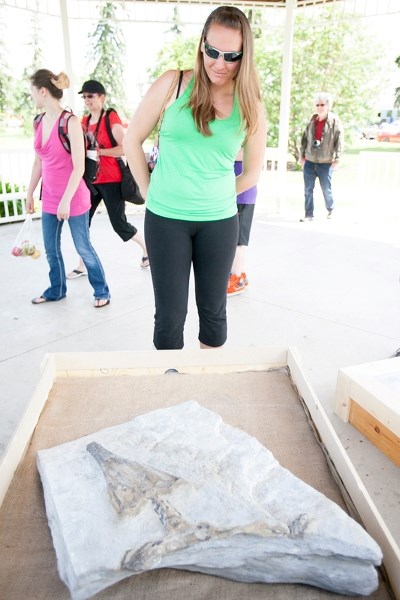The fossilized bones of a prehistoric reptile that called this part of Alberta home 60 million years ago returned to Olds on June 22 as part of Olds College’s centennial celebrations. And a replica of the fossil will now call Olds home.
The fossilized bones of a prehistoric reptile that called this part of Alberta home 60 million years ago returned to Olds on June 22 as part of Olds College’s centennial celebrations.
And a replica of the fossil will now call Olds home.
Leona Megli, a grounds technician at the college, originally thought she had found a discarded banana peel but ended up discovering a partial skull and part of the front limbs of a simoedosaurus, which is a type of champsosaur, at the college in October.
The fossil was taken to the Royal Tyrrell Museum in Drumheller where technicians removed rocks from the bones and made a cast of the fossil that was presented to the college during the centennial celebrations.
"It’s great for the college in their centennial year," Megli said after the unveiling of the mould in Centennial Park.
She added she is still ecstatic to be a part of such an important discovery, since no other champsosaur has ever been found in Alberta.
"It’s thrilling and quite overwhelming actually," she said. "It’s hard to fathom, really. You never think that you’re going to find something really significant."
Just steps away at the park’s gazebo, a trio of technicians from the museum had the original fossil on display and were fielding questions from curious visitors about the reptile, which resembled a modern-day crocodile.
Jim McCabe, a senior laboratory supervisor at the museum, said people were asking how old the fossil is, what the animal ate and what it looked like.
He told people the specimen is an "important fossil" as it provides a number of clues about this type of animal and what the landscape it inhabited looked like.
"It’s a significant fossil because it provides evidence that North America and Europe were once joined," he said. "It’s significant because it’s a type of animal that’s very poorly known from North America."
The technicians also walked visitors through how they unearthed the fossil.
Ramone Nagesan, a fossil preparator technician at the museum, said he worked with other technicians on the fossil from October to January, painstakingly removing miniscule bits of rock from the fossilized bones using an air-scribe, which he described as a "hand-held jackhammer."
The tool, he added, would vibrate on the fossil’s surface and remove tiny pieces of rock in what Nagesan described as a "long and laborious process."
"In a good day you might get four or five square centimetres removed."
But the work, he said, was worth it.
"It’s always really exciting to expose a new specimen because, really, you’re the first person to see this fossil, ever."
College officials have not yet determined where the replica of the fossil will be located at the school, but McCabe said the original specimen will soon go on display at the museum and technicians hope to return to Olds to see if they can unearth the rest of the fossilized bones at the college.
"We would like to investigate every possibility of getting the rest of it. It’s not very likely, but we will be putting out the word that anyone at the college that has any idea of where it might have originally come from to let us know.
"The rest of it might still be in the hill wherever the landscaped rock was gathered. It could be in another chunk of rock that has already been used for landscaping at the college."
[email protected]
